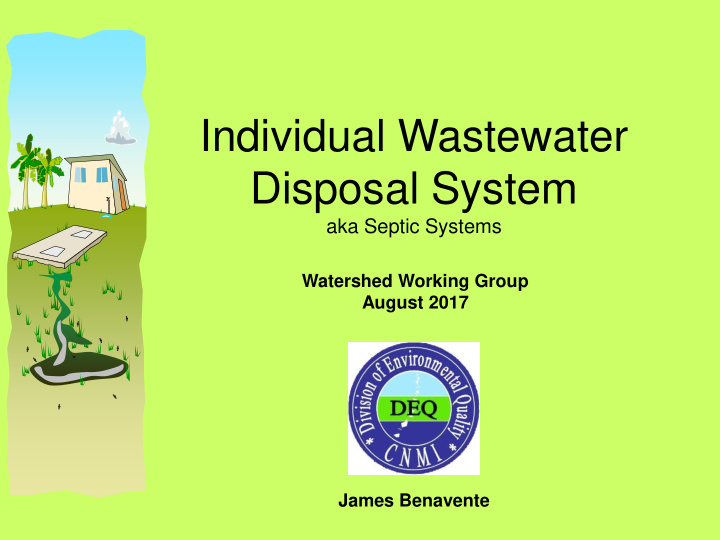



Individual Wastewater Disposal System aka Septic Systems Watershed Working Group August 2017 James Benavente
Individual Wastewater Disposal System • A system designed and installed to treat and dispose of sewage from a single structure or group of structures using a septic tank, together with a leaching field.
Examples
Agenda • Discuss the regulations behind the IWDS • Improve understanding of HOW a septic system works • Understand WHY we must follow very specific design guidelines for a septic system
Wastewater Treatment and Disposal Rules and Regulations • Commonwealth Environmental Protection Act (CEPA) 1982. • Protection of the groundwater and surface water. • All IWDS (Septic Systems) shall be subject to proper design, construction, and operation to provide personal and public benefit.
Wastewater Treatment & Disposal Regulations Identifies: • When and where and IWDS can be built • Process for designing and building an IWDS • Permit requirements • Maintenance requirements
Waste in the CNMI • When a property is within 200 feet of a sewer line, the property MUST be connected to the sewer system • In places where no sewer system is available: need IWDS
Waste in the CNMI
IWDS (Septic Systems)
Saipan Hydrogeology RAINFALL Porous Limestone Evaporation well RECHARGE Ocean mean sea FRESHWATER level TRANSITION ZONE SALTWATER VOLCANIC ROCK CNMI Division of Environmental Quality 2005 BGB
For our purposes: • WASTEWATER CONTAMINANTS: – 5 categories: • Stuff that sinks • Stuff that floats • Stuff that is dissolved • Stuff that is suspended • Pathogenic microorganisms
Liquid Wastes • 2 nutrients in wastewater that give us problems – Ammonium (nitrogen) • Toxic to many organisms • Lasts a long time in the environment – Orthophosphates (phosphorus) • Opposite of ammonium: it is actually very beneficial to most life forms • Bacteria feed on orthophosphates, and the bacteria is harmful to humans
IWDS (Septic Systems)
Solid Wastes • Septic tank allows for solids to be separated from the liquid wastewater
Septic Tank • Allows solids to separate – Some solids float to top – Some solids sink to bottom
Septic Tank • Minimum tank height: 6ft – Accommodate minimum liquid depth, air spaces, and tee heights
Septic Tank Inlet & Outlet • Inlet and outlet height – inlet must be 2 inches above outlet
Septic Tank • Structural requirements: – Walls must be at least 6 inches thick – Walls must be reinforced concrete or reinforced hollow block – Required solid foundation, 4 inch min – Specific Rebar requirements for size and placement • #4 in most cases • #5 if expecting vehicle loads – Lined with Concrete mortar (or similar material)
Septic Tank • Summary: – If a septic tank is designed properly • Solids will be trapped in the tank • The tank will be structurally sound • Liquids will flow freely to leaching field – Treatment • Stuff that sinks • Stuff that floats • Stuff that is dissolved and suspended What about harmful microorganisms?
perforated pipe gravel bed
Leaching Field Treatment • Lots of microbes live and grow in the soil that comprises the leaching field – Leaching field is rich in oxygen – Phosphates provide “food” for microbes • Any other contaminants are also digested by microbes
Leaching Field Design • Layers: – Backfill material – Geotextile: – Washed Aggregate – Natural Soil Backfill material Geotextile sheet Leaching field bed Natural Soil Groundwater
Leaching Field Design • Percolation test – Measures how fast water flows downward – Minimum: 0.67 in/hr – Maximum: 30 in/hr
Leaching Field – Drain Pipe • Drain line specifics – 4 inch PVC pipe • Pipe diameter is large enough to ensure that no clogging will occur – Can be schedule 40 or schedule 80 • Depends on expected surface load 4 inches
Leaching Field • 6 ft between each line and 3 ft between line and edge of leaching field 3 feet 3 feet 3 feet 3 feet
Leaching Field
Leaching Field Drain Pipe
Leaching Field • Holes in pipe must be 30 degrees below centerline, ½ inch diameter, and 6 inches apart – This allows waste to spread evenly all the way down the length of the pipe If holes are at the very bottom of pipe
Leaching Field • Distribution box – Only used if necessary to spread flow across more than 2 lines – if not perfectly level, one or more lines of the leaching field may never get any use! Inlet pipe baffle Slightly lower
Leaching Field Design • Summary – Leaching field is sized based on flow and percolation rate – Leaching field design just as important as septic tank – The field creates a treatment zone for useful microbes to do their thing
Recommend
More recommend